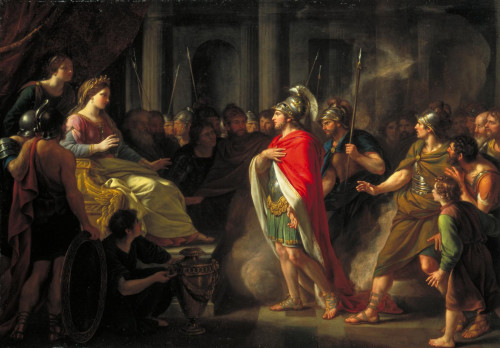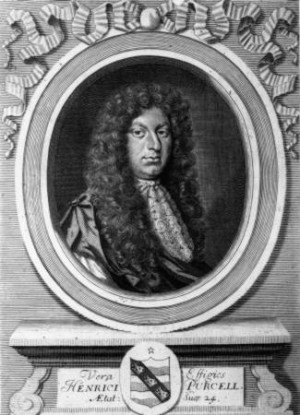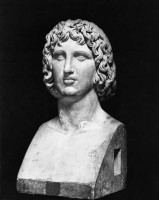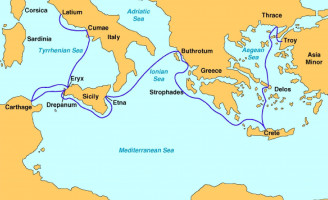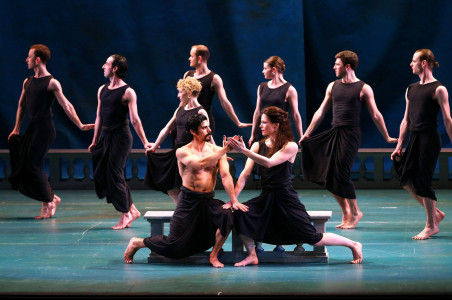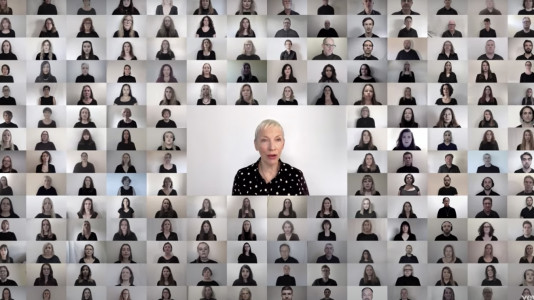This digital study guide is a collaboration between Manitoba Opera and the University of Manitoba Opera Theatre.
As you explore the opera, you’ll meet and hear from members of the cast from the University of Manitoba’s 2020 production of Dido and Aeneas!
Please be advised that the story of Dido and Aeneas contains themes of self-harm.
Introducing Dido and Aeneas
This 17th-century English opera captures a fragment of The Aeneid, a Latin epic written by the poet Virgil. The tragic tale of the affair between the queen of Carthage and her lover the prince of Troy is centered on themes of love, duty, power, and destiny. Still widely performed – over 300 years since its premiere – the opera owes its longtime success in part to its reputation for being an accessible work for young performers, its recurrent use as a textbook example for Baroque musical forms, and its timeless themes.
Characters
Principal Cast
Dido
Queen of Carthage – weary from warring with a neighboring country, seeks to strengthen her kingdom. Dido is wise and resourceful, but also passionate, proud, and wrathful. Dido is also called Elissa, and was formerly the ruler of Tyre. The role of Dido is typically sung by a mezzo-soprano, but can also be sung by a soprano.
Aeneas
Trojan prince. Leads his people in exile after their defeat by the Greeks (as recounted in the Iliad of Homer). Although he falls in love with Dido, he values the fate of his people over his personal happiness. The only male principal in the opera, Aeneas is sung by a tenor or by a mezzo-soprano.
Belinda
Dido’s sister and advisor. Like the queen, she also wants Carthage to regain its former glory. She sees Aeneas, and her sister’s love for him, as a means to that end. Belinda is sung by a soprano.
Sorceress
(sometimes sorcerer), a powerful witch who wants to see Carthage destroyed. She fixates on Dido, believing that if she can ruin the queen, the country will fall. She sees Dido’s love for Aeneas as a weakness that can be exploited. The voice type of the sorceress varies by performance.
Spirit
(Mercury). A servant of the sorceress, the spirit is disguised as the god Mercury to drive apart Dido and Aeneas by convincing the prince to lead his people across the sea to Italy. The Spirit is sung by a soprano.
Supporting Roles
Supporting roles include the Second Woman (a handmaiden of the queen, sung by a soprano), First Witch and Second Witch (minions of the Sorceress, sung by a soprano and a mezzo-soprano), and the First Sailor (a Trojan sailor, sung by a soprano).
Chorus
The chorus is called on to play different roles in different scenes. Throughout the opera they play the roles of courtiers, witches, and sailors.
Synopsis
The Plot of Dido and Aeneas in one minute
Dido, the widowed Queen of Carthage, entertains the Trojan Prince Aeneas, shipwrecked on his way to Italy, where he will found a new Troy. Dido and Aeneas are in love. Witches plot Dido’s destruction and the Sorceress conjures a storm, to break out when the royal couple are hunting, and the impersonation of Mercury by one of her coven. The storm duly breaks and the courtiers hasten back to town, while the false Mercury tells Aeneas he must leave Dido and sail for Italy. Aeneas and his sailors prepare to leave, to the delight of the witches. Aeneas parts from Dido, who kills herself once he has gone, her death lamented by mourning cupids.
(synopsis courtesy of Naxos Records)
Composer
Henry Purcell, an English Baroque-era composer, was born in London in 1659. He demonstrated an aptitude for music at a young age, and enjoyed the privilege of a well-connected family. His uncle Thomas, a musician in His Majesty’s Chapel who had sung at the coronation of King Charles II, arranged for the young Purcell to be admitted as a chorister in the Chapel Royal, starting his lifelong association with music for the royal family. In 1679, he replaced his teacher John Blow as organist for Westminster Abbey. Three years later, he was appointed organist for the Chapel Royal, and continued to hold both positions.
Purcell wrote anthems (liturgical choral works for the Anglican Church), operas, music for plays, and odes and instrumental works dedicated to English royal family, such as his Funeral Sentences and Music for the Funeral of Queen Mary.
Purcell’s best-known work today is his opera Dido and Aeneas. His Te Deum, composed in 1694 for Saint Cecilia’s Day, was the first English setting of the Te Deum with orchestral accompaniment. It was performed annually at St. Paul’s Cathedral until 1712.His collected works were published after his death by his wife, Frances, in two volumes titled Orpheus Britannicus.
Purcell died in 1695, and was buried next to the organ in Westminster Abbey, honouring his life’s work.
Music
Dido and Aeneas is Purcell’s only fully sung operatic work; this means that all the text is sung instead of spoken. This lets the composer make dramatic use of word painting, a technique in which the musical line illustrates the text to emphasize its meaning. Common examples of word painting include rapidly running notes when singing words like “storm” or “fierce,” to demonstrate turbulence or intensity. Word painting helps a composer to emphasize the emotions of the character who is singing.
“Ah, Belinda! I am prest with torment”
Listen to the descending musical line through the words “prest” and “torment,” as Dido sings of her grief.
“What storms, what battles did he sing?”
This tumultuous line effectively paints the text – “storms” is a rapidly ascending melisma, and the word “battles” is pointedly articulated.
Another way that Purcell builds drama through music is in the use of tonality – major and minor keys – to represent the overall feeling of a scene. When the characters are melancholy or agitated, as Dido is in the above examples, the tonality is minor. When the characters are joyful or excited, the tonality is major, as in the following excerpt featuring the chorus singing “Let the triumphs of love and of beauty be shown.”
Many of the scenes feature dance numbers as well as singing – while less prevalent in modern opera, this was extremely common in Baroque-era operas. These dances do not directly serve the plot, and have been omitted from this production.
By far the most famous song in the opera is sung by queen Dido – her aria “When I am laid in earth”, commonly referred to as “Dido’s lament.” It is a textbook example of a ground bass – a repeating pattern or ostinato that serves as the primary structural element in a musical work. Ground bass can also be heard in the keyboard passacaglias of German Baroque composer Johann Sebastian Bach.
History
The Aeneid is a Latin epic written by the poet Virgil between 29 and 19 BC, and is widely regarded as one of the greatest works of Latin literature.
Virgil wove together some of the vague myths and legends about Troy and the founding of Rome into a narrative that recounts the tale of Aeneas, the Trojan prince who traveled to Italy and became the ancestor of the Romans. The first six books of the epic tell the story of the Trojans wandering in exile after their defeat by the Greeks (as told in the Iliad of Homer); the fourth book finds the Trojans across the sea in northern Africa (what is now Tunisia), and recounts the fiery but tragic passion of Dido and Aeneas. One key difference between the poem and the opera is this: Virgil’s epic features the Roman gods as characters whose machinations interfere in the fates of Dido and Aeneas, while the conflict in Purcell’s opera is driven by the meddling of the Sorceress and her minions.
Contemporary Adaptations of Dido and Aenea
In recent decades, several adaptations have been produced that breathe new creative life into the opera. Dido and Aeneas has been adapted for dance several times, including productions for ballet and modern dance. In one notable adaptation by American choreographer Mark Morris, the title characters are portrayed by both a dancer and a singer; that production has been produced 32 times since its premiere in 1989.
In 2019, the Toronto-based Opera Q and Cor Unum Ensemble collaborated to create Dido and Belinda, which tells the story from Belinda’s perspective. The opera is extended with passages of spoken text that make the story more about Dido and her sister, and less about the queen of Carthage and the prince of Troy.
In December 2020 the internet woke up to a new project by singer/songwriter Annie Lennox – a virtual choral recording of “Dido’s lament” through Zoom with London City Voices. “Dido’s lament” is used as commentary on the lack of global response to climate change, treating it as an elegy for a dying planet.
University of Manitoba Opera Theatre & Symphony Orchestra’s 2020 Production
Producing an opera in uncertain times requires creativity and dedication – read about how the faculty and students at U of M rose to the challenge of producing Dido and Aeneas in the fall of 2020, in during the COVID-19 pandemic.
This production of Dido and Aeneas was inspired by limitations. Limitations can be an artist’s best friend as they help you to focus on finite possibilities, rather than the daunting task of figuring out what you want to do when the possibilities are endless.
The first limitation was personnel – there simply weren’t enough tenors, baritones, and basses in this year’s advanced voice program, and those in the undergraduate program had schedule conflicts that didn’t allow them to participate. There aren’t many operas written for all sopranos and mezzos, but Dido and Aeneas was performed by a school for young women shortly after it was written. When music director Naomi Woo and stage director Katherine Twaddle met to discuss the production, they each came up with the idea of an all-female production of Dido and Aeneas. It would be a collaboration between the U of M Opera Theatre and Symphony Orchestra, which occurs every two years.
The second limitation was Covid-19, which required singers to be at 6 feet away from each other and to wear masks at all times, even while singing. The physical distancing led to the idea of the Dido feeling isolated from her courtiers, and alone with her internal struggle as she finds herself attracted to Aeneas but feels guilty at the idea of betraying her vow to honour her late husband by remaining a widow.
The masks gave the singers an opportunity to create a strong physical interpretation, using their whole body to communicate, rather than just relying on their faces alongside their voices. In a physical theatre production, like this one, performers rely on their bodies and physical skills to allow them to portray more than one character. This way the Sorceress can also be a courtier and Dido can also be a witch, with no costume changes.
In a minimalist production like this one, everything comes from the performers. The costumes are basic black and there is no set. All the information regarding character and story must come from their physical acting and singing techniques.
Purcell composed Dido and Aeneas during the baroque era when the use of choreographed, stylized gestures was the acting style for opera productions. Using gesture is a great way for a singer to get inside the words and really communicate their understanding of the text. Not only did our singers learn about a historic style of acting, they also learnt a technique that really helped to convey meaning even though their facial expressions were limited by the masks.
Listen to some of the performers reflect on their experience with the production.



